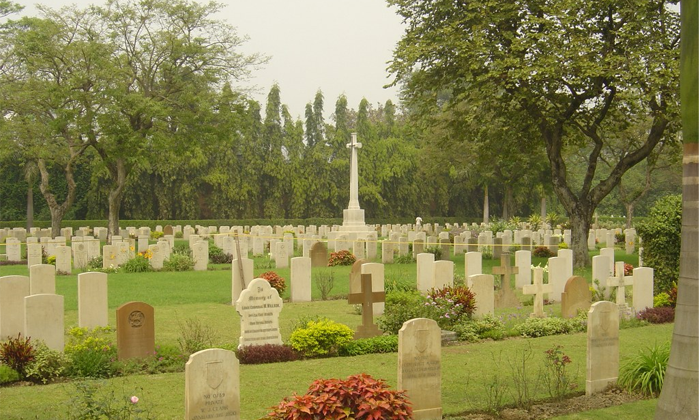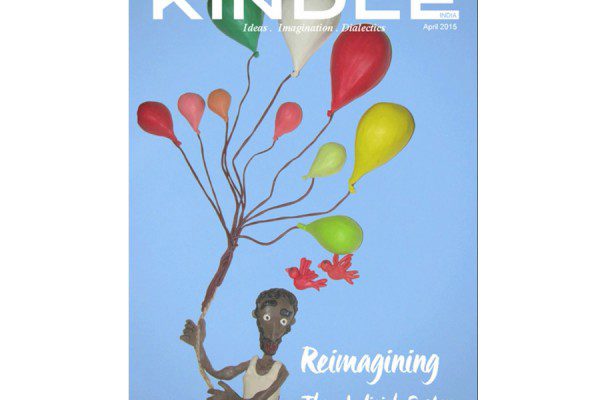A sign above the door claims: “The Bhowanipore Graveyard “. Fake-looking fountains greet you at the gate. Grave markers, all flush with the ground, overlay acres and acres of uninterrupted lawn. Like name tags at a conference, the markers blur into a generic wash of strangers: Sarbonda Sarkar, William Marshall, Elelbeth Barwell, Jonanna Roy, P.L. Roy. The guard at the entrance gives me directions to the gravesite I’m looking for. “Cross the new cemetery, and walk straight to the old one. That’s where you’ll find him”.
The new cemetery’s tombstones are small, white, and homogeneous, like well tended teeth. Three burly men in lungis and a cross around their necks shout over the racket of a backhoe that lifts a coffin by a chain, and swings it into a grave. When the coffin doesn’t fit, the fattest one stands on it, gives it weight and pushes it down. The preacher is a fiery man, waving his fists and declaiming that hell is a real, scorching, dreary place without maach bhaat or hope. The old cemetery is just steps away from this sight and its tombstones, if they are at all like teeth, they are derelict—some round, some with cavities, most of them blemished.
Sonu Singh, my interviewee, a third generation tombstone maker, bites down hard on the filter of his beedi as he plunges a chisel deep into the granite for rewriting on a tombstone. “He died as he lived” carving on this tombstone was inappropriate. The relative who ordered the epitaph had a change of heart – on the recommendation of other family members who suggested that if the stone wasn`t changed, he might soon be joining him. “I’m just going to fill in the gaping space and carve in `Rest in Peace’,” says Singh. “It won`t look as good, but what can you do? It happens. People change their minds at the last minute.” For the next few minutes, slivers of rock spit from the tombstone. “We have to. It`s got to be just accurate because this”, he says, rubbing the chips off the stone “is how they`ll be remembered.”
“Attention to detail is essential in this business,” he says with an eyebrow raised. “Look at this rough base of this stone that covers the grave,” he says, pointing at a grave. “A few years back, gardeners were trimming grasses but the weed eating machines chipped at polished granite along with the grass, so now we require the bases of monuments to have a rough finish so the chipping won’t be so obvious.”
Singh takes me to his workshop the next day. The stonecutters lug around huge stones tied to bamboo poles and pound away at the stone slabs in the tube light lit rooms of the noisy Radhabazaar Street of North Kolkata, often spilling out onto the streets.
Inside, the selection of stone for engraving ranges from standard white marble to more steeply priced black granites and green marbles resting on squares of artificial green grass to capture the feel of a real cemetery. The store is filled with samples of their work. On one family gravestone, a granny who was a knitter is remembered by a spool of wool, a feather in an inkwell for a man who was a writer, the scales of justice for an activist, and a pair of red gloves for a boxer. The Orissa style ‘rekha deul’ bordering and black basalt carvings indicate a distinctive esteem for the Hindu faith. The engravers also boast of doing simple inlay work with green and red stones.
“I’m the sole designer of Kishori Mistri Engravers. We have six carvers. I end up carving too when we get time,” he says. “A traditional Christian and Muslim epitaph includes the name of the deceased, the birth and death dates, the cause of death, the names of family members and the date when the headstone was erected. Christians are easy to work with but Muslims are a bit fussy. They don’t let us climb onto the graves to fix the stone and are particular about who carves it. But well, we entertain all kinds of clients. The customers also get to choose the font”, and he pulls out an album of their portfolio. “Roman English is the most common. We also draw in Script type and Statesmen type. I can challenge you that none of the cutters have seen the face of school but with their experience in the industry, they can read and write. Not just English, even Urdu, Bengali, Hindi; we are pretty familiar with all languages. I even remember making a foundation stone written in Spanish which was exported to Cambodia.”
Working from pencil-drawn letters, symbols and sculptures, the carvers tap away at the stone with only acheda and a mallet to create pieces of custom art. “A tombstone can take between one to 4 days depending on the number of letters and complexity of the font.” He points at a deep callous on his little finger. ‘I’m very proud to have this. This means that I am a full-fledged monument maker.” Singh explains that a part of mastering the trade means hitting the finger used to secure the etching tool so many times, it shows the cuts and bruises.
I articulate my quiet anxiety to Sonu Singh about death of tombstone makers in the silhouette of our modern cemeteries: no tombstones, more generic, refusing to say anything about the people crumbling under the lawns. Time has turned tombstone making, with no pun intended, into a dying art.To which he says, “You know, most of us won’t be buried also. My corpse, and yours, will probably be shoved into ovens which these big phoren organisations promote these days, heated to somewhere between 1400 and 2100 degrees and turned into ash. And here in Kolkata, where the beautiful Hooghly manages to romance even hard-core atheists, lot of people choose to be cremated and sprinkled at sea. ‘Seko aur chidko (bake and shake), we call it”, he says, with tongue firmly in his cheek.
The last few years have seen the death industry get dirty. “Most people buying funeral stuff can be herded like sheep and taken advantage of because they’re in shock,” says KP Bainsal, another tombstone vendor on Radhabazaar Street. “The heights of aggressive sales in this industry can make you choke. The vendors will charge you double the price for coffins, for arranging priests and arranging tombstones on a short notice. Even getting a grave site can get difficult sometimes. So people choose to go to electric crematoriums than bury their loved ones. ”
“This is probably the world`s second oldest profession. People have been doing this since the beginning of time,” adds Maqbool defensively, a lanky carver listening to our conversation. “But I know a lot of people in this business, and I don`t know one who has gotten richer doing this. Well, not in a financial sense. But a few people still stick around with the business. Most are born into it. And a lot stay in it because it`s still an art. My father, who is 83 years old, still comes by and helps out once in a while when we need some beat and strike work. Adds Singh, “Haan, 83 and he`s still smoking cheap beedis while swinging the hammer. You ought to see it.”
“You know, I hate cemeteries”, says Maqbool. “They are grotesque, with their swampy grounds, higgledy- piggledy memorials, desolate places with that creepy sound of garden mowers rolling endlessly over the dead. But then, we also hear a lot of sad stories about how kids die. “You see people at the worst possible moments of heartbreak and hurt—pain that’s weighty to me.”
“There was the teenager, my nephew, in Tollygunge who had terrible acne, so doctors prescribed a medicine and soon afterward the kid’s kidneys gave out, a rare side effect of the drug. He was a beautiful spirit. He needed something special to mark his place. So I made him a black marble tombstone with glass marker.”
He pulls out the picture of the tomb from his album. Looking into it is like looking into a slice of water. Through it, I can see the blurred landscape of the cemetery, flowers and trees bending dreamily in the wind.Minuscule bubbles in the glass marker appear to rise with the sun rays, like in a glass of champagne. The tombstone Maqbool made looks evanescent. Just like his profession.


